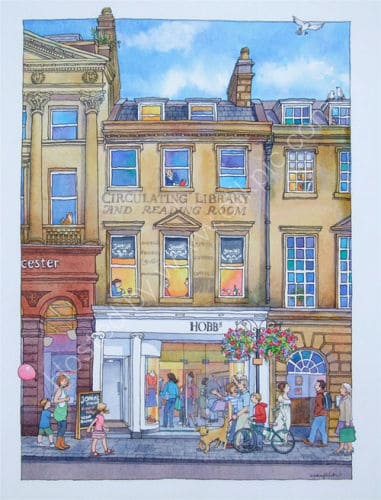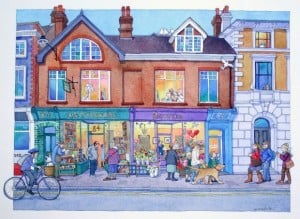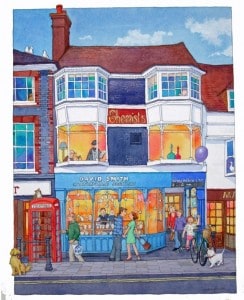5 Sep 2012
Lyndsey Smith and the signs of Bath and Lewes
The Circulating Library sign from Bath is certainly one of the most popular and regularly photographed ghostsigns in the UK [See comments on this post for some more on this sign]. However, this is the first time I’ve seen it appear in watercolour. This painting by Lyndsey Smith was the runner up in the Bath Prize of 2010 and I got in touch with Lyndsey to ask about her work.
1. Please tell me a little about your work and your approach to creating your pieces.
I have always been interested in old photographs and comparing them to the present day, also in archaeology and old tales of times gone by. I always find myself looking up above shop fronts for clues from the past, maybe the bracket from an old shop sign or light fitting, or signs of paint on the walls.
I love to draw and paint, and initially began exhibiting regular landscapes. Then I trialled exhibiting my drawings with people and they were popular. Now I can exhibit what I really enjoy most.
I love to find a building that has some point of interest, including any form of lettering, old or new, although I rarely paint the plastic signs. I try to find a story about the building if I can, and imagine how it might have been before, and the people that might have been there behind the windows.
This painting is of Dusarts, or what used to be Dusarts, in Lewes. Mr Dusart used to do ladies hair (so I put him upstairs) It also used to be a baths with hot water, hence the lady in the towel.
3. You have featured ghostsigns in a handful of your pieces. What interests you about these faded pieces of advertising from the past?
The ghostsigns are another clue to the past. I wish I could time travel and see them when they were first painted!
4. Some of your pieces show shops and scenes from Bath, a city famed for its ghostsigns. When did you first start noticing them and at what point did they start to appear in your work?
I am actually based in Lewes, which has 1,000 years of history. When I was very little, my uncle lived near Fishbourne Roman Palace and we visited. I was fascinated in clues from the past from then on. I also used to love looking at the old photos that our local paper used to print, and look to see what clues remained on the buildings that still stood. The signs in Bath were a natural progression of this interest.
5. Can you tell me anything else about your work, its connection with ghostsigns and your plans for the future?
There are so many places I would like to paint. I only visited Bath for the first time two years ago, when I entered the Bath Prize painting competition. We were allocated a mystery place to paint and I was given Milsom Street. I hadn’t heard of it. When I googled it and found it was voted as one of the most beautiful shopping streets in Britain I knew I had the right place for me! When I went there to paint and found the Circulating Library I knew it was meant to be! I have now been back many times and have painted seven or eight paintings…but there are so many more I want to do too!
I am currently working on some paintings of Lewes, two more lovely old buildings, one has a very small ghostsign that has been saved, and the other has cleaner brickwork where one might have been…and both include some lovely present day hand painted lettering.
One day I would like to do a book about the history of a single shop. A picture book with a different decade on each page. A time travelling book to encourage people to think about the shops and the buildings that line our high street, the way I do!
6. Where can people see more of your painting and keep up with your work?
I have a series of galleries on my main website and you can follow work in progress on new pieces on my blog.
Thanks for taking the time to speak with me and I’ll keep an eye on the blog for more work featuring ghostsigns. And good luck in any future prizes, hopefully next time you can take home the winners medal.





